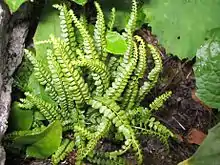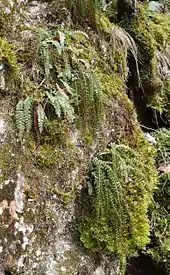Asplenium viride
Asplenium viride is a species of fern known as the green spleenwort because of its green stipes and rachides. This feature easily distinguishes it from the very similar-looking maidenhair spleenwort, Asplenium trichomanes.
| Green spleenwort | |
|---|---|
 | |
| Scientific classification | |
| Kingdom: | Plantae |
| Clade: | Tracheophytes |
| Division: | Polypodiophyta |
| Class: | Polypodiopsida |
| Order: | Polypodiales |
| Suborder: | Aspleniineae |
| Family: | Aspleniaceae |
| Genus: | Asplenium |
| Species: | A. viride |
| Binomial name | |
| Asplenium viride | |

Taxonomy
Green spleenwort was described by Carl Linnaeus in his 1753 Species Plantarum, under the name "Asplenium Trich. ramosum", with a type locality of "in Arvorniæ rupibus" (rocks in Caernarfonshire).[1] Under the rules of the International Code of Botanical Nomenclature, phrase names such as "Asplenium Trichomanes ramosum" are to be treated as orthographic errors – in this case, for "Asplenium ramosum".[2] That name was later rejected in favour of William Hudson's later name Asplenium viride,[3] which had a type locality of "in rupibus humidis in montibus Walliæ et in comitatibus Eboracensi et Westmorlandico" (damp rocks in the mountains of Wales, Yorkshire and Westmorland).[4]
A global phylogeny of Asplenium published in 2020 divided the genus into eleven clades,[5] which were given informal names pending further taxonomic study. A. viride belongs to the "A. viride subclade" of the "A. trichomanes clade".[6] The A. trichomanes clade has a worldwide distribution. Members of the clade grow on rocks and usually have once-pinnate leaf blades with slender, chestnut- to dark-brown stalks. The A. viride subclade, which contains only A. viride and its allopolyploid descendant A. adulterinum, is exceptional in having green stalks.[7]
Ecology
A. viride is a native species of northern and western North America and northern Europe and Asia. It is a small rock fern, growing on calcareous rock. It is a diploid species, with n = 36, and hybridizes with Asplenium trichomanes to produce Asplenium × adulterinum, found on Vancouver Island, British Columbia.
References
- Carl Linnaeus (1753). Species plantarum: exhibentes plantas rite cognitas, ad genera relatas, cum differentiis specificis, nominibus trivialibus, synonymis selectis, locis natalibus, secundum systema sexuale digestas. Vol. 2. Stockholm: Impensis Laurentii Salvii.
- W. Greuter; F. R. Barrie; H. M. Burder; W. G. Chaloner; V. Demoulin; D. L. Hawksworth; P. M. Jørgensen; D. H. Nicholson; P. C. Silva; P. Trehane; J. McNeill, eds. (1994). "Article 23: Names of species". International Code of Botanical Nomenclature (Tokyo Code). Regnum Vegetabile 131. Königstein: Koeltz Scientific Books. ISBN 3-87429-367-X.
- Zimmer, B.; Greuter, W. "Proposal to Reject the Name Asplenium ramosum L. (Pteridophyta)". Taxon. 43 (2): 303–304. doi:10.2307/1222897. JSTOR 1222897.
- William Hudson (1798). Flora anglica (3rd ed.). R. Faulder. p. 453.
- Xu et al. 2020, p. 27.
- Xu et al. 2020, p. 39.
- Xu et al. 2020, p. 44.
- Xu, Ke-Wang; Zhang, Liang; Rothfels, Carl J.; Smith, Alan R.; Viane, Ronald; Lorence, David; Wood, Kenneth R.; Cheng, Cheng-Wei; Knapp, Ralf; Zhou, Lin; Lu, Ngan Thi; Zhou, Xin-Mao; Wei, Hong-Jin; Fan, Qiang; Chen, Su-Fang; Cicuzza, Daniele; Gao, Xin-Fen; Li, Wen-Bo; Zhang, Li-Bing (2020). "A global plastid phylogeny of the fern genus Asplenium (Aspleniaceae)". Cladistics. 36 (1): 22–71. doi:10.1111/cla.12384. PMID 34618950. S2CID 201197385.
External links
 Data related to Asplenium viride at Wikispecies
Data related to Asplenium viride at Wikispecies Media related to Asplenium viride at Wikimedia Commons
Media related to Asplenium viride at Wikimedia Commons- Flora of North America: Asplenium viride
- Asplenium viride Green Spleenwort, Wild Flowers of the British Isles
- Asplenium viride Archived 2018-06-17 at the Wayback Machine, Skye Flora
- Asplenium viride, Flora of Northern Ireland
